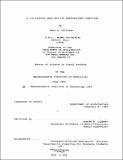| dc.contributor.advisor | Andrew B. Lippman. | en_US |
| dc.contributor.author | Callahan, Mark A | en_US |
| dc.contributor.other | Massachusetts Institute of Technology. Dept. of Architecture. | en_US |
| dc.date.accessioned | 2012-07-02T15:19:41Z | |
| dc.date.available | 2012-07-02T15:19:41Z | |
| dc.date.copyright | 1983 | en_US |
| dc.date.issued | 1983 | en_US |
| dc.identifier.uri | http://hdl.handle.net/1721.1/71348 | |
| dc.description | Thesis (M.S.V.S.)--Massachusetts Institute of Technology, Dept. of Architecture, 1983. | en_US |
| dc.description | MICROFICHE COPY AVAILABLE IN ARCHIVES AND ROTCH | en_US |
| dc.description | Includes bibliographical references (leaves 106-109). | en_US |
| dc.description.abstract | This thesis covers the design and implementation of a binocular display head-set akin to Dr . Ivan E. Sutherland's head-mounted display, but using several new technologies and new techniques in computer graphics: small portable video display, transmitter and receiver; write-once optical video disc recorder; a magnetic position sensor, and a depth cue based animation package. This implementation has permitted the creation of a highly interactive three dimensional trainer/simulator . Computer generated controlled images are optically mixed into the surrounding environment by imaging through two beamsplitter mirrors positioned in front of the viewer's eyes. The source of the images on the display head-set is two Sony Flat CRT's mounted on top of the head-set pointing downward. The beamsplitter mirrors are angled out from the bottom of a pair of eyeglasses. Normal vision is through the eyeglasses; the TV images are reflected in the mirrors . The viewer is able to manipulate the display image by "touching" and "moving" the image with his hand, or even to "look around" the display image. A position sensor located on either the viewers hand or the head-set itself provides the - input for the manipulation. Stereo for 3-D viewing is obtained by transmitting two video sources to the two receivers on two OHF channels located in a small beltpack. This thesis also describes a write-once optical video disc recorder that is used to store "pre-computed" view-point dependent images. The images of a scene were recorded in coherent segments to create a visual data base; included were full rotations and general movements of stereoscopic image pairs. Real-time manipulation of the pre-recorded images is done though fast-executing commands on the optical write-once recorder. The graphics package permits quick construction and scripting of objects. To increase the sensation of 3-D, special attention is paid to the inclusion and the highlighting of physiological and psychological depth cues. | en_US |
| dc.description.statementofresponsibility | by Mark A. Callahan. | en_US |
| dc.format.extent | 110 leaves | en_US |
| dc.language.iso | eng | en_US |
| dc.publisher | Massachusetts Institute of Technology | en_US |
| dc.rights | M.I.T. theses are protected by
copyright. They may be viewed from this source for any purpose, but
reproduction or distribution in any format is prohibited without written
permission. See provided URL for inquiries about permission. | en_US |
| dc.rights.uri | http://dspace.mit.edu/handle/1721.1/7582 | en_US |
| dc.subject | Architecture. | en_US |
| dc.title | A 3-D display head-set for personalized computing | en_US |
| dc.type | Thesis | en_US |
| dc.description.degree | M.S.V.S. | en_US |
| dc.contributor.department | Massachusetts Institute of Technology. Department of Architecture | |
| dc.identifier.oclc | 11504013 | en_US |
